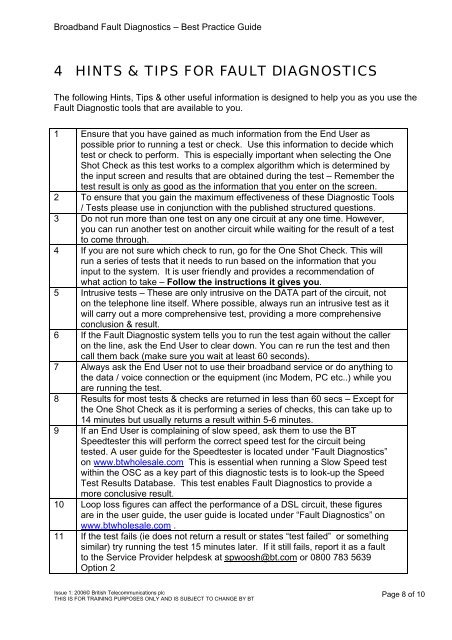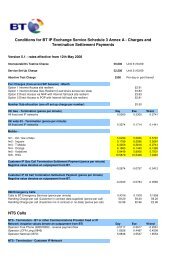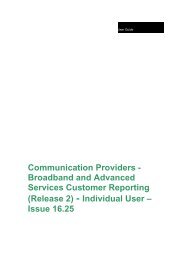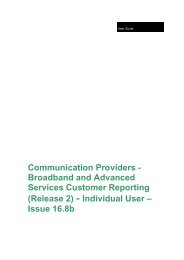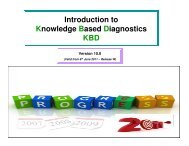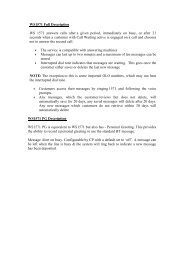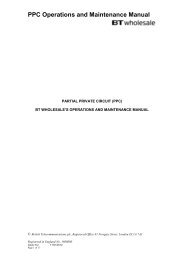BROADBAND FAULT DIAGNOSTICS A BEST PRACTICE GUIDE
broadband fault diagnostics a best practice guide - BT Wholesale
broadband fault diagnostics a best practice guide - BT Wholesale
- No tags were found...
Create successful ePaper yourself
Turn your PDF publications into a flip-book with our unique Google optimized e-Paper software.
Broadband Fault Diagnostics – Best Practice Guide4 HINTS & TIPS FOR <strong>FAULT</strong> <strong>DIAGNOSTICS</strong>The following Hints, Tips & other useful information is designed to help you as you use theFault Diagnostic tools that are available to you.1 Ensure that you have gained as much information from the End User aspossible prior to running a test or check. Use this information to decide whichtest or check to perform. This is especially important when selecting the OneShot Check as this test works to a complex algorithm which is determined bythe input screen and results that are obtained during the test – Remember thetest result is only as good as the information that you enter on the screen.2 To ensure that you gain the maximum effectiveness of these Diagnostic Tools/ Tests please use in conjunction with the published structured questions.3 Do not run more than one test on any one circuit at any one time. However,you can run another test on another circuit while waiting for the result of a testto come through.4 If you are not sure which check to run, go for the One Shot Check. This willrun a series of tests that it needs to run based on the information that youinput to the system. It is user friendly and provides a recommendation ofwhat action to take – Follow the instructions it gives you.5 Intrusive tests – These are only intrusive on the DATA part of the circuit, noton the telephone line itself. Where possible, always run an intrusive test as itwill carry out a more comprehensive test, providing a more comprehensiveconclusion & result.6 If the Fault Diagnostic system tells you to run the test again without the calleron the line, ask the End User to clear down. You can re run the test and thencall them back (make sure you wait at least 60 seconds).7 Always ask the End User not to use their broadband service or do anything tothe data / voice connection or the equipment (inc Modem, PC etc..) while youare running the test.8 Results for most tests & checks are returned in less than 60 secs – Except forthe One Shot Check as it is performing a series of checks, this can take up to14 minutes but usually returns a result within 5-6 minutes.9 If an End User is complaining of slow speed, ask them to use the BTSpeedtester this will perform the correct speed test for the circuit beingtested. A user guide for the Speedtester is located under “Fault Diagnostics”on www.btwholesale.com This is essential when running a Slow Speed testwithin the OSC as a key part of this diagnostic tests is to look-up the SpeedTest Results Database. This test enables Fault Diagnostics to provide amore conclusive result.10 Loop loss figures can affect the performance of a DSL circuit, these figuresare in the user guide, the user guide is located under “Fault Diagnostics” onwww.btwholesale.com .11 If the test fails (ie does not return a result or states “test failed” or somethingsimilar) try running the test 15 minutes later. If it still fails, report it as a faultto the Service Provider helpdesk at spwoosh@bt.com or 0800 783 5639Option 2Issue 1: 2006© British Telecommunications plcTHIS IS FOR TRAINING PURPOSES ONLY AND IS SUBJECT TO CHANGE BY BTPage 8 of 10


